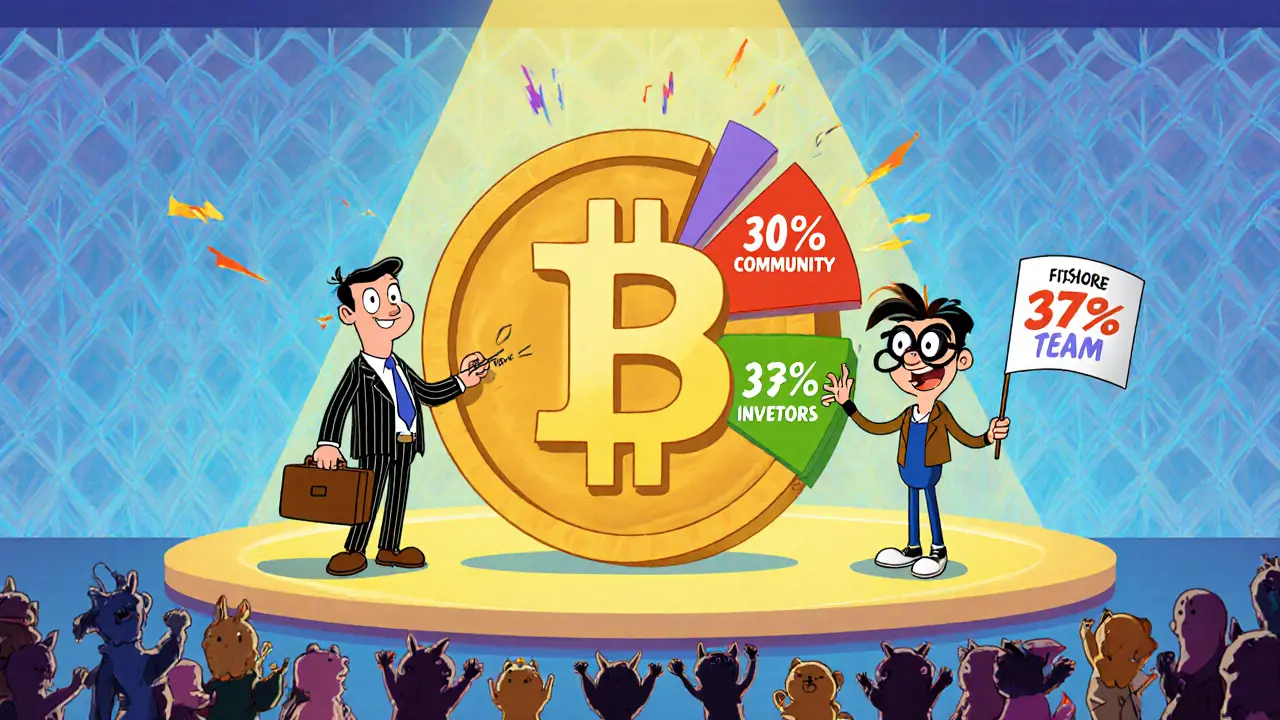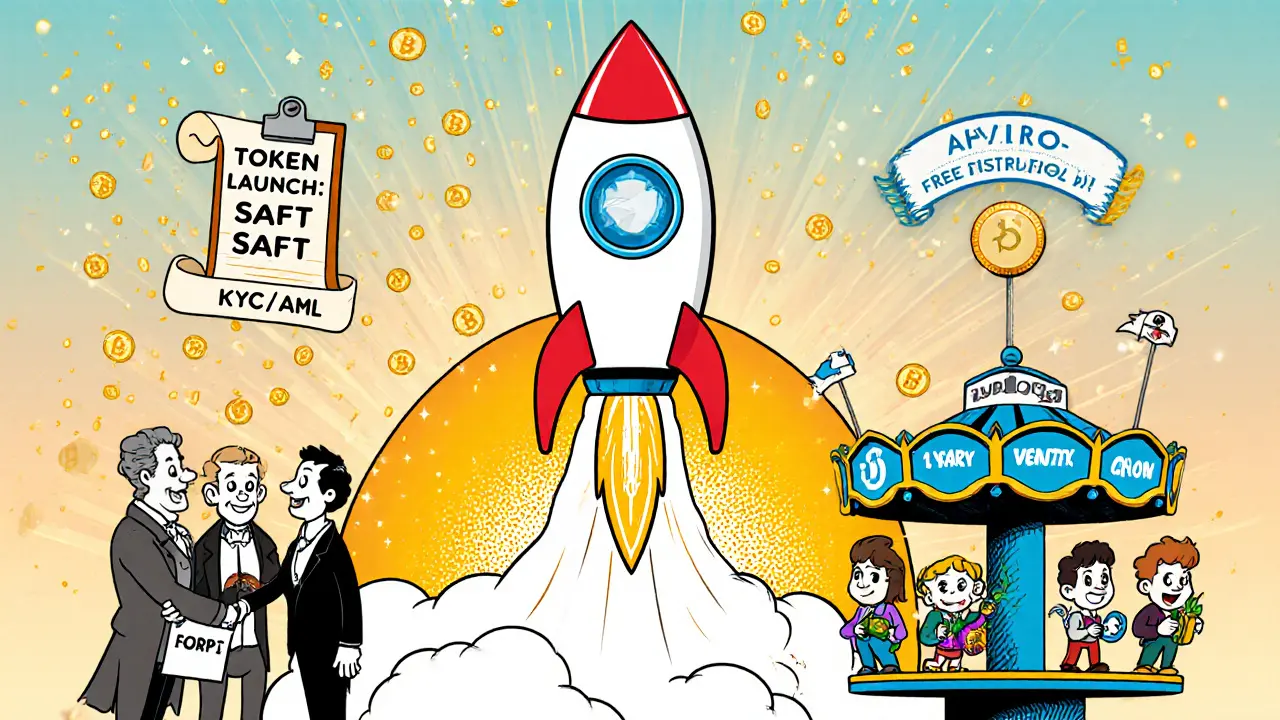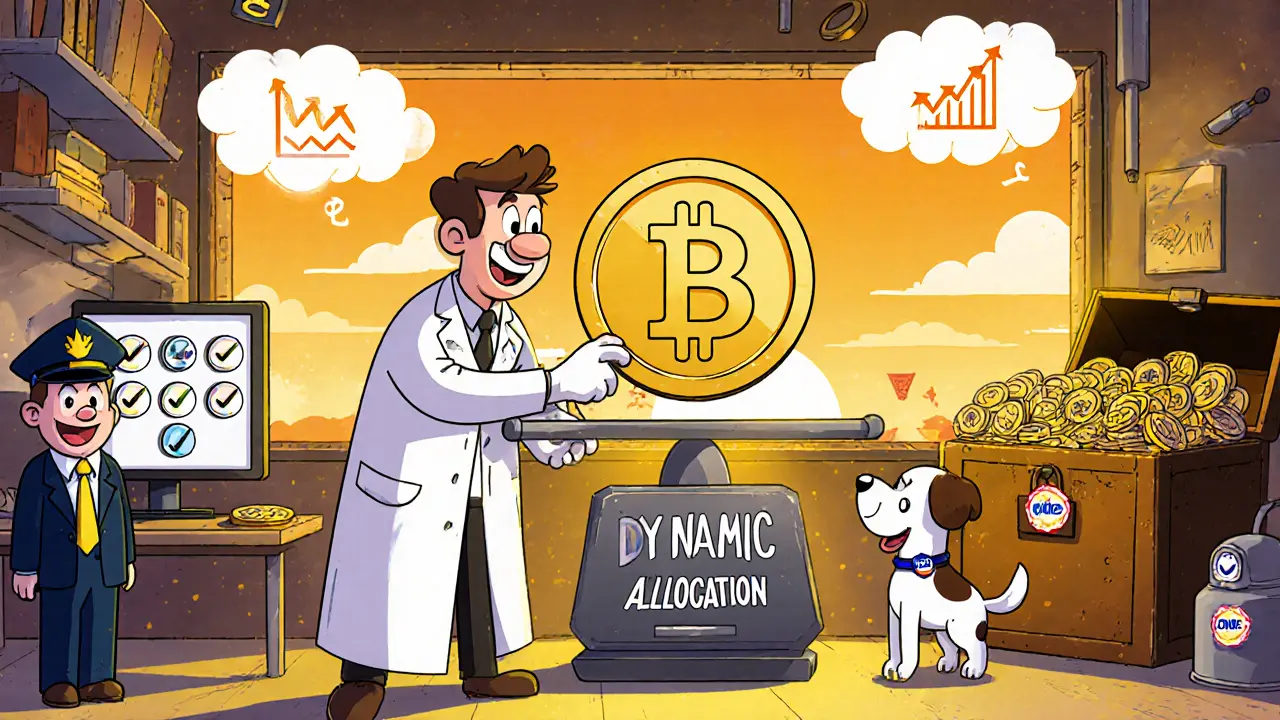Token Distribution Models: How Crypto Projects Allocate Tokens
 Jul, 11 2025
Jul, 11 2025
Token Distribution Planner
Legend:
Key Takeaways
- Token distribution models shape a project's security, liquidity, and community growth.
- Hybrid approaches-mixing paid sales with free airdrops-are now the industry norm.
- Long‑term vesting (3‑4 years) for team tokens correlates with higher survival rates.
- Allocating at least 30% of supply to community incentives drives user‑base expansion.
- Regulatory compliance (SAFTs, KYC/AML) adds 3‑6 months and $150k‑$500k to launch budgets.
When a blockchain project launches, Token Distribution Models are the strategic frameworks used to allocate cryptocurrency tokens among developers, investors, community members, and the project team . The way a token is split can make or break the ecosystem - it influences price stability, governance power, and how quickly a community forms. Below we break down the most common models, the numbers that matter, and practical steps to design a distribution that survives both market cycles and regulator scrutiny.
Why Token Distribution Matters
Tokenomics isn’t just fancy math; it’s the living contract between a protocol and its participants. Research from BlockApps (2024) shows projects with a clear, transparent allocation plan raise 12% more capital in the first six months. Meanwhile, a Token Terminal 2024 report found that protocols dedicating over 30% of supply to community rewards see 2.3× higher user‑growth than those that keep the pie tightly in founders’ hands. In short, a well‑balanced distribution fuels funding, decentralization, and long‑term utility.
Core Metrics Every Distribution Needs
Before picking a model, get these numbers straight:
- Total Supply is the maximum number of tokens that will ever exist - e.g., Bitcoin caps at 21million.
- Circulating Supply counts tokens that are actively tradable in the market - a high circulating‑to‑total ratio often signals lower inflation risk.
- Vesting Schedule defines when locked tokens become transferable - typical team vesting runs 4years with a 1‑year cliff.
- Allocation Percentages show how the total supply is split among stakeholder groups - think 33% investors, 30% community, 37% team.

Paid Distribution Models
Paid models bring in the cash needed for development, marketing, and ecosystem grants. They differ mainly in who can buy and how the sale is structured.
1. SAFT (Simple Agreement for Future Tokens)
First used by Protocol Labs in 2017, a SAFT is a contractual promise to deliver tokens once the network launches. Investors lock in at a discount, and the agreement is framed as a security to satisfy regulators. LegalNodes (2023) notes SAFT documentation can cost $150k‑$250k, but the structure keeps the project out of the SEC’s unregistered‑offering radar.
2. Private Token Sale
Here, venture capital firms buy a large chunk before the public ever sees a token. Solana’s 2021 private sale raised $314million with discounts of 30‑50% versus projected market price. The upside is fast funding; the downside is a potential perception of centralization if the private tranche exceeds 20% of total supply.
3. Public Sale (ICO, IEO, IDO)
Public sales let anyone with crypto participate. ICOs peaked in 2017-2018, accounting for 89% of all distributions, but regulatory crackdowns slashed their popularity. Modern IDOs on launchpads (e.g., Polkastarter) combine token generation events with built‑in KYC, reducing compliance risk. Still, the SEC’s 2023 enforcement report shows 139 parties charged for unregistered offerings, so thorough legal reviews are non‑negotiable.
Free Distribution Models
Free models focus on community building, network effects, and decentralization. They rarely raise capital directly, but they can bootstrap liquidity and user adoption.
1. Airdrop
An Airdrop delivers free tokens to a set of eligible wallets. Uniswap’s 2020 airdrop handed 400UNI tokens to early users, representing 15% of its supply. The benefit is instant community buzz, yet a Chainalysis (2022) study flagged that 27% of airdropped tokens were sold the same day, indicating “airdrop farmer” behavior.
2. Lockdrop
With a Lockdrop participants lock existing tokens on one chain to earn new tokens on another, projects reward commitment. Cosmos’ 2018 lockdrop required users to lock ATOM for weeks, fostering a loyal validator set while limiting immediate market sell‑pressure.
3. Staking & Reward Systems
Protocols like Ethereum pay Staking Rewards as a percentage of the total supply to validators who secure the network. Current yields sit at 3‑5% annually, which both incentivizes participation and injects a predictable inflation rate. Terra’s 2022 failure underscored the risk of unsustainable yields - when rewards outrun economic fundamentals, token values can crash.
Hybrid Models - The New Standard
Most successful projects today blend paid and free methods. A typical hybrid rollout looks like this:
- Seed round with strategic investors (SAFT or private sale) - 15% of supply.
- Public IDO - 10% of supply, with KYC built in.
- Community airdrop - 5% of supply, targeted at early adopters.
- Staking & liquidity mining pool - 10% of supply released over 3 years.
- Reserve treasury - 20% held for future grants, ecosystem growth, and governance.
- Team & advisors - 20% locked with a 4‑year vesting schedule.
This mix raises capital, spreads tokens widely, and keeps a sizable treasury for long‑term development - exactly what Magna.so (2023) recommends: at least 15% for community governance and a 30%+ community allocation for healthy growth.
Comparison Table: Paid vs Free Distribution Models
| Aspect | Paid Models (SAFT, Private Sale, ICO/IDO) | Free Models (Airdrop, Lockdrop, Staking) |
|---|---|---|
| Capital Raised | High - often >$100M for large projects | Low - primarily community goodwill |
| Regulatory Burden | High - requires KYC/AML, legal docs | Medium - may need AML for large airdrops |
| Distribution Speed | Fast - tokens transferred after sale closes | Gradual - often tied to on‑chain actions |
| Risk of Centralization | Higher if private tranche >20% | Lower when airdrop targets diverse wallets |
| Community Engagement | Moderate - depends on post‑sale incentives | High - users earn tokens by participating |

Designing Your Own Distribution Blueprint
Follow these steps to craft a model that matches your project’s goals and regulatory environment.
- Define project objectives. Is the priority fundraising, decentralization, or rapid user acquisition?
- Map stakeholder groups. Typical categories: founders & team, advisors, private investors, public investors, ecosystem treasury, community rewards.
- Set allocation percentages. Use benchmarks - e.g., 33% investors, 30% community, 20% team (vested), 17% treasury.
- Choose distribution mechanisms. Pair a private SAFT with a 5% airdrop and a 10% staking pool.
- Design vesting contracts. Implement a 1‑year cliff and linear release over 3‑4 years for team tokens.
- Integrate compliance. Adopt KYC/AML providers (e.g., Chainalysis KYT) and draft legal wrappers (SAFT, token purchase agreements).
- Build transparent reporting. Publish an audited cap table, update quarterly, and host it on a public GitHub repo.
- Run simulations. Model price impact of major unlock events; adjust lock‑up periods if projected price drop exceeds 20%.
PixelPlex (2024) estimates that completing these steps takes 3‑6 months and $150k‑$500k in professional services. Skipping any of them often leads to token price crashes or regulatory fines.
Common Pitfalls & How to Avoid Them
- Over‑allocating to early investors. When private sales exceed 25% of supply, projects risk community backlash and lower token velocity.
- Poor vesting contracts. 42% of projects experience token‑unlock slumps; using audited, time‑locked smart contracts mitigates surprise dumps.
- Ignoring regional regulations. MiCA (EU) now mandates quarterly allocation disclosures; failing to comply can halt token listings in Europe.
- Launching airdrops without anti‑farm measures. Require on‑chain activity (e.g., minimum transaction count) to filter out bots.
- Insufficient treasury funding. Allocate at least 10% of raised capital for ongoing development; otherwise you’ll run out of runway within a year.
Future Trends to Watch
Regulators are tightening the net. By 2024, 68% of new projects used SEC‑compliant SAFTs, and the EU’s MiCA rules enforce quarterly transparency. Expect more hybrid models that blend tokenized real‑world assets (RWAs) with traditional securities compliance - Ondo Finance’s USDY stablecoin is a prime example, pulling $1.2billion in institutional capital.
Dynamic allocation is gaining traction. Protocols like KlimaDAO now shift distribution percentages based on market volatility, helping smooth price swings. According to a 2024 DeFi Llama survey, 27% of new projects include some form of algorithmic rebalancing.
Looking ahead to 2026, Messari predicts that 80% of successful token projects will run multi‑phase distribution plans with community‑controlled treasuries holding over 40% of total supply. If you start designing your model today with these trends in mind, you’ll be well‑positioned for the next wave of token launches.
Frequently Asked Questions
What is the difference between a SAFT and an ICO?
A SAFT is a contractual agreement where investors purchase the right to receive tokens after the network launches, often framed as a security to meet regulator requirements. An ICO sells actual tokens directly to the public, usually without a formal securities wrapper, which makes it more vulnerable to enforcement actions.
How long should a team’s vesting schedule be?
Industry data from Blockchain.com (2023) shows that a 4‑year vesting period with a 1‑year cliff yields the highest survival rate. Shorter schedules tend to increase price volatility when tokens unlock.
Can I run an airdrop without violating AML regulations?
Yes, if you screen recipients against sanctioned lists and limit the drop to wallets that have performed on‑chain activity. Many projects use KYC providers for large‑scale airdrops to stay compliant.
What percentage of tokens should be reserved for community governance?
Magna.so recommends at least 15% of total supply be allocated to a community treasury that can vote on protocol upgrades, grants, and treasury spending.
How do I calculate token velocity?
Token velocity = (Total Transaction Volume over a period) ÷ (Average Circulating Supply during that period). Keeping velocity below 5 transactions per token per day helps limit speculative pressure.
Mureil Stueber
July 11, 2025 AT 16:44Token distribution is more than just numbers on a slide; it sets the incentives for everyone involved.
Keeping the investor slice around a third usually gives enough runway for development while leaving room for community growth.
A four‑year vesting with a one‑year cliff for the team is a solid default that many projects adopt.
Don’t forget to allocate a healthy treasury-around 15‑20%-so the protocol can fund grants and upgrades without selling tokens.
Transparency in the cap table builds trust early on.
Emily Kondrk
July 14, 2025 AT 06:44Whatever they’re feeding you with those “standard” 33‑30‑20‑17 splits, it’s a manufactured illusion of fairness!
Behind the scenes, the “private sale” is just a front for whales to lock up the market before a pump‑and‑dump cycle kicks in.
Look for hidden clauses, back‑door minting rights, and you’ll see the real game.
Laura Myers
July 16, 2025 AT 20:44Okay, let’s break this down like a drama at a coffee shop.
First act: the investors swoop in, flash their cash, and demand a nice chunk of the pie.
Second act: the team and advisors get a cozy 20%, but only if they promise not to jump ship.
Third act: the community rewards get a respectable 30%, which is the audience’s applause.
Fourth act: the treasury sits in the shadows, a mysterious 17% that can either save the day or become a black hole.
The plot twist? If the vesting schedule is too short, the token price can nosedive after the “launch party.”
Bottom line: balance the characters, give each a clear motivation, and the story won’t flop.
Leo McCloskey
July 19, 2025 AT 10:44Honestly, the whole tokenomics template is a tired cliché, a recycled script that many founders paste without real thought, and it’s infuriating!
They claim “30% community allocation” as if that guarantees decentralization, yet they lock the real power behind a handful of pre‑sale wallets, a blatant contradiction.
Furthermore, the excessive jargon-“liquidity mining,” “staking rewards”-obscures the fact that most of these mechanisms are just yield‑farms for early adopters.
Where is the genuine attempt at equitable distribution? It’s nowhere to be found, and it’s a moral failing.
Anjali Govind
July 22, 2025 AT 00:44I think the guide does a good job of outlining the basics, but a few practical tips could help newcomers.
First, run a simple spreadsheet to model different vesting scenarios and see how token velocity changes over time.
Second, consider a small “activity‑based” airdrop that rewards wallets with on‑chain transactions instead of just a snapshot.
Third, keep the treasury transparent by publishing monthly reports on how the funds are used.
These steps can make the distribution feel more inclusive and trustworthy.
Ted Lucas
July 24, 2025 AT 14:44🚀 Staking pools are the rocket fuel for community growth!
When you allocate a solid 10‑15% to liquidity mining, you create a win‑win: users earn rewards while the token gains depth on the market.
Don’t forget to cap the annual inflation rate, or you’ll scare off long‑term holders!
💪 Keep the vesting schedule tight, and watch the ecosystem soar.
ചഞ്ചൽ അനസൂയ
July 27, 2025 AT 04:44Think of the token allocation like a garden: you plant seeds (community rewards), water them (treasury grants), and prune the overgrown vines (excess investor tokens).
When the balance is right, the whole ecosystem blossoms and sustains itself.
Remember to periodically review the vesting cliffs; they’re the pruning shears that prevent a sudden overgrowth that could choke the market.
Jacob Moore
July 29, 2025 AT 18:44Here’s a quick checklist:
- Set investor allocation ≤ 35% to avoid centralization.
- Reserve 15‑20% for a treasury that can fund future grants.
- Use a 4‑year linear vesting with a 1‑year cliff for the team.
Follow these and you’ll have a solid foundation.
Siddharth Murugesan
August 1, 2025 AT 08:44i cant beleive how many projects dump their token after 6 monthz its like a sick joke dont you think its a sign of shadey plans ?
Hanna Regehr
August 3, 2025 AT 22:44The article covers the essentials, but let’s add a bit more nuance.
When designing the allocation, consider the market’s appetite for risk and the project's stage.
Early‑stage startups might benefit from a slightly larger investor share to secure runway, while more mature protocols should tilt toward community incentives.
Also, keep an eye on regulatory developments; a compliant SAFT can save you months of legal headaches.
Ben Parker
August 6, 2025 AT 12:44Great post! 👍
Daron Stenvold
August 9, 2025 AT 02:44The tokenomics landscape has evolved dramatically over the past few years, and understanding the underlying incentives is crucial for any aspiring participant.
First, a well‑structured vesting schedule aligns the team’s interests with the long‑term health of the protocol, reducing the risk of sudden token dumps that can destabilize markets.
Second, allocating a meaningful portion of the supply to community rewards fosters organic growth, as users become both stakeholders and promoters.
Third, a robust treasury serves as a financial safety net, enabling continuous development, strategic partnerships, and emergency grants without resorting to inflationary token releases.
Fourth, transparency in the cap table builds credibility; publishing audited reports reassures investors and regulators alike.
Fifth, the balance between paid and free distribution methods should reflect the project’s fundraising needs and decentralization goals.
Sixth, integrating compliance mechanisms such as KYC for large airdrops mitigates anti‑money‑laundering concerns while preserving the inclusive spirit of the ecosystem.
Seventh, dynamic allocation models, which adjust distribution percentages based on market volatility, can smooth price swings and protect token holders.
Eighth, community governance tokens, when locked behind voting thresholds, empower users to guide protocol upgrades and resource allocation.
Ninth, continuous monitoring of token velocity helps detect speculative bubbles early, allowing the team to implement corrective measures.
Tenth, collaborating with reputable legal counsel during the SAFT drafting phase prevents costly regulatory setbacks.
Eleventh, involving third‑party auditors to verify smart‑contract vesting logic adds an extra layer of trust.
Twelfth, fostering cross‑chain interoperability can unlock new utility for the token, expanding its use cases beyond the native platform.
Thirteenth, incentivizing long‑term holding through staking rewards must be balanced against inflation to avoid eroding token value.
Fourteenth, periodic community feedback sessions ensure the distribution model remains aligned with evolving user expectations.
Finally, maintaining flexibility in the allocation roadmap allows the project to adapt to unexpected market conditions, ensuring sustainability and resilience.
hrishchika Kumar
August 11, 2025 AT 16:44Insightful breakdown! I especially appreciate the point about dynamic allocation smoothing volatility-something many projects overlook.
From a community perspective, having regular feedback loops and transparent treasury reporting builds the trust needed for long‑term participation.
Balancing staking rewards with inflation is indeed a delicate act, and I’ve seen protocols succeed when they tie rewards to measurable network contributions.